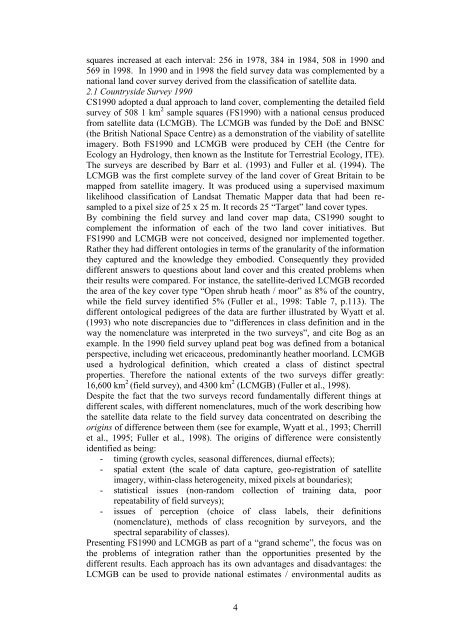Actor Network Theory - Leicester Research Archive - University of ...
Actor Network Theory - Leicester Research Archive - University of ...
Actor Network Theory - Leicester Research Archive - University of ...
Create successful ePaper yourself
Turn your PDF publications into a flip-book with our unique Google optimized e-Paper software.
squares increased at each interval: 256 in 1978, 384 in 1984, 508 in 1990 and<br />
569 in 1998. In 1990 and in 1998 the field survey data was complemented by a<br />
national land cover survey derived from the classification <strong>of</strong> satellite data.<br />
2.1 Countryside Survey 1990<br />
CS1990 adopted a dual approach to land cover, complementing the detailed field<br />
survey <strong>of</strong> 508 1 km 2 sample squares (FS1990) with a national census produced<br />
from satellite data (LCMGB). The LCMGB was funded by the DoE and BNSC<br />
(the British National Space Centre) as a demonstration <strong>of</strong> the viability <strong>of</strong> satellite<br />
imagery. Both FS1990 and LCMGB were produced by CEH (the Centre for<br />
Ecology an Hydrology, then known as the Institute for Terrestrial Ecology, ITE).<br />
The surveys are described by Barr et al. (1993) and Fuller et al. (1994). The<br />
LCMGB was the first complete survey <strong>of</strong> the land cover <strong>of</strong> Great Britain to be<br />
mapped from satellite imagery. It was produced using a supervised maximum<br />
likelihood classification <strong>of</strong> Landsat Thematic Mapper data that had been resampled<br />
to a pixel size <strong>of</strong> 25 x 25 m. It records 25 ―Target‖ land cover types.<br />
By combining the field survey and land cover map data, CS1990 sought to<br />
complement the information <strong>of</strong> each <strong>of</strong> the two land cover initiatives. But<br />
FS1990 and LCMGB were not conceived, designed nor implemented together.<br />
Rather they had different ontologies in terms <strong>of</strong> the granularity <strong>of</strong> the information<br />
they captured and the knowledge they embodied. Consequently they provided<br />
different answers to questions about land cover and this created problems when<br />
their results were compared. For instance, the satellite-derived LCMGB recorded<br />
the area <strong>of</strong> the key cover type ―Open shrub heath / moor‖ as 8% <strong>of</strong> the country,<br />
while the field survey identified 5% (Fuller et al., 1998: Table 7, p.113). The<br />
different ontological pedigrees <strong>of</strong> the data are further illustrated by Wyatt et al.<br />
(1993) who note discrepancies due to ―differences in class definition and in the<br />
way the nomenclature was interpreted in the two surveys‖, and cite Bog as an<br />
example. In the 1990 field survey upland peat bog was defined from a botanical<br />
perspective, including wet ericaceous, predominantly heather moorland. LCMGB<br />
used a hydrological definition, which created a class <strong>of</strong> distinct spectral<br />
properties. Therefore the national extents <strong>of</strong> the two surveys differ greatly:<br />
16,600 km 2 (field survey), and 4300 km 2 (LCMGB) (Fuller et al., 1998).<br />
Despite the fact that the two surveys record fundamentally different things at<br />
different scales, with different nomenclatures, much <strong>of</strong> the work describing how<br />
the satellite data relate to the field survey data concentrated on describing the<br />
origins <strong>of</strong> difference between them (see for example, Wyatt et al., 1993; Cherrill<br />
et al., 1995; Fuller et al., 1998). The origins <strong>of</strong> difference were consistently<br />
identified as being:<br />
- timing (growth cycles, seasonal differences, diurnal effects);<br />
- spatial extent (the scale <strong>of</strong> data capture, geo-registration <strong>of</strong> satellite<br />
imagery, within-class heterogeneity, mixed pixels at boundaries);<br />
- statistical issues (non-random collection <strong>of</strong> training data, poor<br />
repeatability <strong>of</strong> field surveys);<br />
- issues <strong>of</strong> perception (choice <strong>of</strong> class labels, their definitions<br />
(nomenclature), methods <strong>of</strong> class recognition by surveyors, and the<br />
spectral separability <strong>of</strong> classes).<br />
Presenting FS1990 and LCMGB as part <strong>of</strong> a ―grand scheme‖, the focus was on<br />
the problems <strong>of</strong> integration rather than the opportunities presented by the<br />
different results. Each approach has its own advantages and disadvantages: the<br />
LCMGB can be used to provide national estimates / environmental audits as<br />
4














